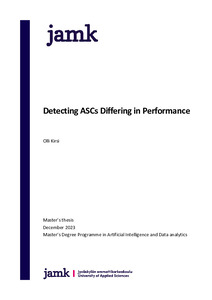Detecting ASCs Differing in Performance
Kirsi, Olli (2023)
Kirsi, Olli
2023
Julkaisun pysyvä osoite on
https://urn.fi/URN:NBN:fi:amk-2023121738011
https://urn.fi/URN:NBN:fi:amk-2023121738011
Tiivistelmä
Containerized trade has grown steadily for decades. Increasing trade volumes required highly productive
and advanced port cranes. The focus shifted towards autonomous ASCs that performed most of the activities without human interference. The objective of the thesis was to detect poorly performing cranes out of
the good ones using artificial intelligence. The research method was research-based development.
Most of the KPIs for port cranes measure the performance of the cranes by also including many external
factors outside control of the machine suppliers. This presented a challenge to machine suppliers on how to
monitor the crane performance. To solve the challenge, a new KPI, move residual, was proposed for the
ASCs.
Move residual negated the effects of external factors that are present in other KPIs. The move residual was
calculated by predicting the cycle times of the container moves with linear regression. The linear model
was trained with only normal and uneventful moves. Domain knowledge and statistical methods were utilized to filter out the bad moves from the training data. The predicted cycle time was then deducted from
the actual cycle time. As a result, the predicted cycle time was compared to a predicted cycle time. In conclusion, the performance of ASC, with external factors excluded, can be monitored with the move residual.
Move residual was used as a quantitative performance measurement and anomaly score simultaneously.
and advanced port cranes. The focus shifted towards autonomous ASCs that performed most of the activities without human interference. The objective of the thesis was to detect poorly performing cranes out of
the good ones using artificial intelligence. The research method was research-based development.
Most of the KPIs for port cranes measure the performance of the cranes by also including many external
factors outside control of the machine suppliers. This presented a challenge to machine suppliers on how to
monitor the crane performance. To solve the challenge, a new KPI, move residual, was proposed for the
ASCs.
Move residual negated the effects of external factors that are present in other KPIs. The move residual was
calculated by predicting the cycle times of the container moves with linear regression. The linear model
was trained with only normal and uneventful moves. Domain knowledge and statistical methods were utilized to filter out the bad moves from the training data. The predicted cycle time was then deducted from
the actual cycle time. As a result, the predicted cycle time was compared to a predicted cycle time. In conclusion, the performance of ASC, with external factors excluded, can be monitored with the move residual.
Move residual was used as a quantitative performance measurement and anomaly score simultaneously.
